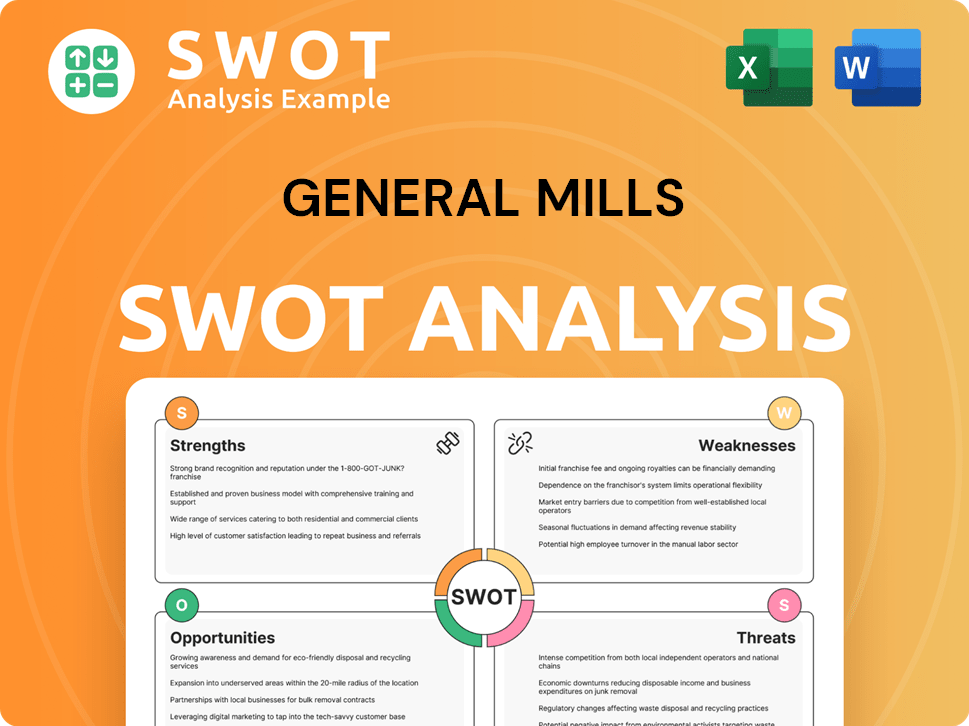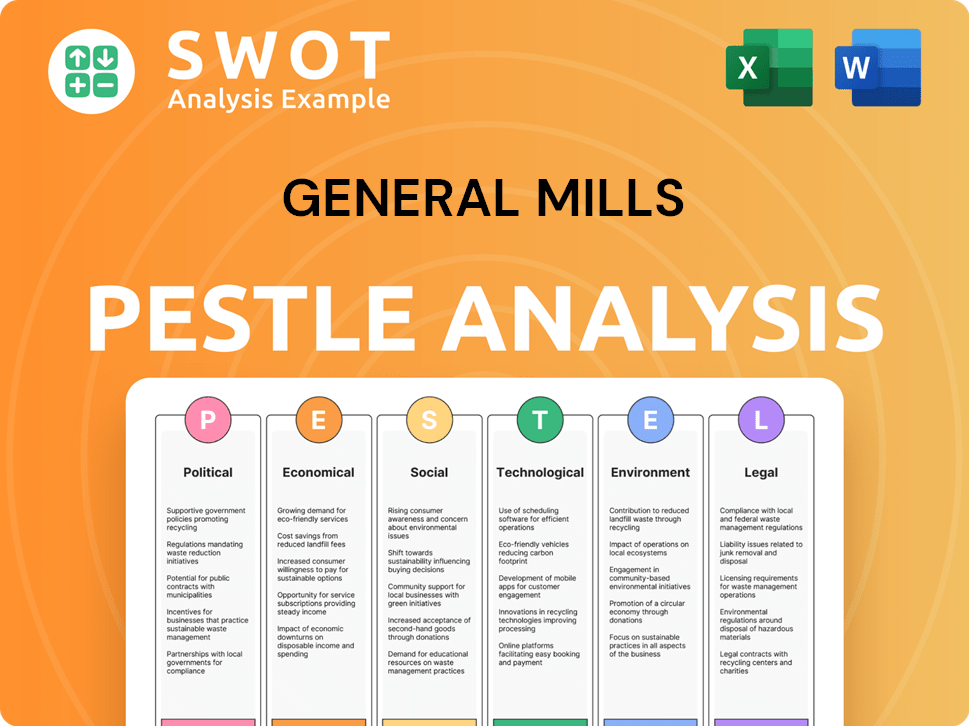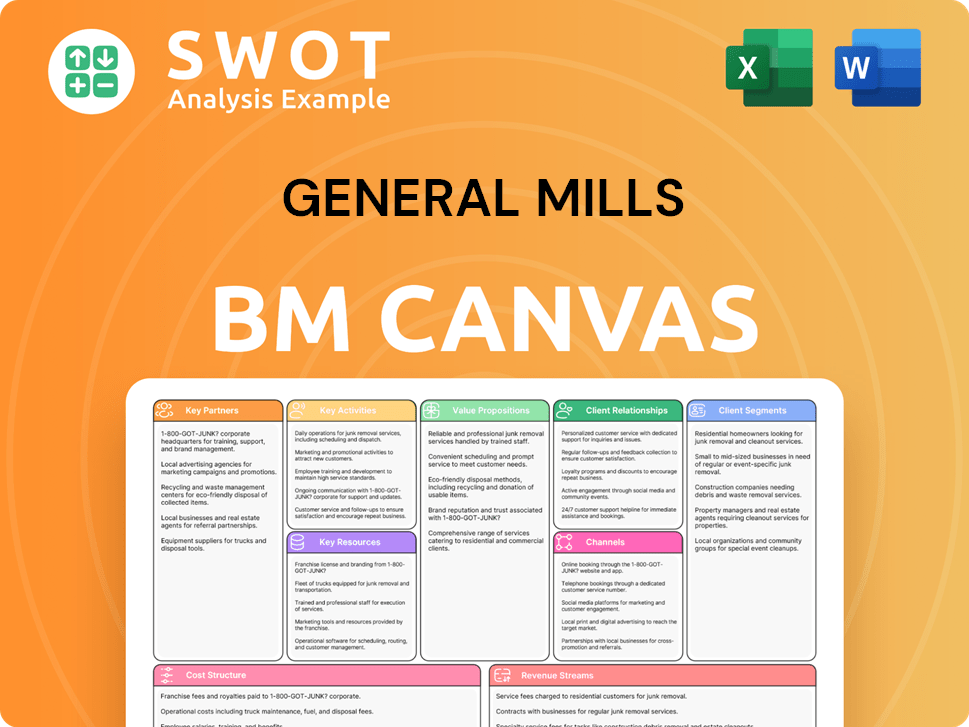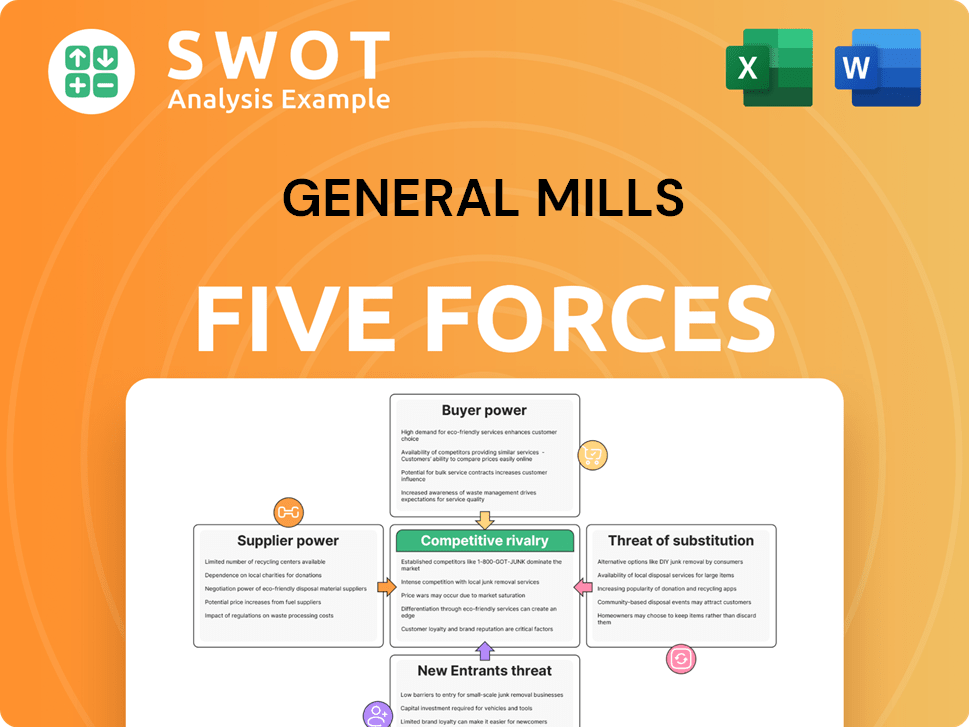General Mills Bundle
How Does General Mills Dominate the Grocery Aisle?
General Mills, a titan in the food industry since 1928, has masterfully adapted its General Mills SWOT Analysis to stay ahead of consumer trends. From its humble beginnings as a flour milling company, General Mills has transformed into a global powerhouse, boasting iconic brands like Cheerios and Nature Valley. This evolution highlights a dynamic sales and marketing strategy essential for success in today's competitive market.

To understand General Mills' enduring success, we'll delve into its sophisticated marketing plan, exploring how it leverages diverse sales channels and innovative marketing tactics. We'll also examine its strategic brand positioning and how it effectively reaches its target audience. This analysis will provide valuable insights into General Mills' sales strategy, its impressive market share, and its ability to consistently deliver strong sales performance.
How Does General Mills Reach Its Customers?
The sales strategy of General Mills is built on a multi-channel approach, ensuring its diverse product range reaches consumers through various avenues. This strategy encompasses traditional retail, e-commerce, and wholesale distribution, each playing a crucial role in the company's market presence. The company continually adapts its sales channels to align with evolving consumer behaviors and market trends, focusing on both physical and digital retail environments.
General Mills' marketing strategy is designed to maintain its market share and drive growth. The company’s approach includes leveraging its strong brand portfolio and adapting to the changing retail landscape, including the rise of online grocery shopping. The company's marketing plan is comprehensive, covering everything from product placement in physical stores to digital marketing campaigns.
Understanding the distribution strategy is key to the success of General Mills. This involves strategic partnerships and omnichannel integration to provide a seamless shopping experience. The company's sales performance analysis reveals the effectiveness of its multi-channel approach, with traditional retail still holding a significant share while digital channels continue to grow. If you want to learn more about the company, you can read about Owners & Shareholders of General Mills.
General Mills heavily relies on traditional retail channels, including supermarkets, mass merchandisers, club stores, and convenience stores. These physical locations remain a cornerstone of the company's sales volume, ensuring broad product accessibility. The company adapts to changes in the retail landscape, such as the growth of discount retailers and the increasing importance of private label brands.
The company has strategically enhanced its e-commerce presence, recognizing the growth of online grocery shopping. General Mills products are available through major online retailers like Amazon and Walmart.com. The company also leverages its brand websites for direct-to-consumer (DTC) sales, particularly for niche or premium offerings, such as those under its Blue Buffalo pet food segment.
General Mills maintains strong relationships with wholesale distributors, facilitating the widespread distribution of its products to various retail outlets. This distribution network ensures that General Mills products are available in a wide array of stores. This approach supports the company's overall distribution strategy and market reach.
Strategic partnerships with key retailers are crucial, often involving tailored merchandising programs and promotional activities. Collaborations with major grocery chains ensure prominent shelf placement and participation in store-specific marketing initiatives. These partnerships are a key component of General Mills' marketing strategy.
The performance of General Mills' sales channels varies, with traditional retail still accounting for the largest share of sales. Digital channels are experiencing significant growth, aligning with broader industry trends. The company continues to invest in omnichannel integration, aiming to provide a seamless shopping experience for consumers across all touchpoints. General Mills' recent marketing initiatives reflect the importance of adapting to changing consumer behaviors and market dynamics.
- Traditional retail remains a cornerstone, providing a substantial portion of sales.
- E-commerce is experiencing significant growth, driven by the expansion of online grocery shopping.
- Strategic partnerships with retailers are essential for shelf placement and promotional activities.
- Omnichannel integration is a key focus, aiming to provide a seamless shopping experience.
General Mills SWOT Analysis
- Complete SWOT Breakdown
- Fully Customizable
- Editable in Excel & Word
- Professional Formatting
- Investor-Ready Format

What Marketing Tactics Does General Mills Use?
The company, a major player in the food industry, employs a multifaceted marketing approach to boost brand recognition, generate demand, and drive sales. This strategy integrates both digital and traditional media to reach a broad consumer base. Understanding the General Mills sales strategy and General Mills marketing strategy is key to appreciating its market position.
The General Mills marketing plan is dynamic, adapting to the ever-changing media landscape. It focuses on connecting with consumers where they are most active, whether online or through traditional channels. The company's marketing efforts are also heavily influenced by data analytics, allowing for targeted campaigns and personalized messaging.
The company's marketing mix has evolved considerably, with a notable shift towards digital channels and personalized engagement, reflecting its commitment to staying relevant in a rapidly changing media landscape and connecting with consumers where they are most active. For insights into the company's overall business model, consider reading Revenue Streams & Business Model of General Mills.
The company utilizes content marketing through recipes, lifestyle blogs, and nutritional information to engage consumers. SEO ensures its brands appear prominently in search results. Paid advertising across digital platforms, including display ads and video advertising, is used to reach targeted audiences.
Social media platforms such as Facebook, Instagram, TikTok, and Pinterest are integral for community building. Interactive campaigns and showcasing product versatility are common strategies. The company actively engages in influencer partnerships to promote its products.
The company continues to invest in TV advertising, radio spots, and print media for its flagship brands. These traditional channels are used to reach broad consumer bases, ensuring widespread brand awareness. This approach complements its digital efforts.
The company uses consumer insights and analytics to inform product development and target specific customer segments. Technology platforms and analytics tools are used to track campaign performance. CRM systems and marketing automation platforms help manage customer interactions.
Email marketing campaigns are deployed to nurture customer relationships and promote new products. Exclusive deals and promotions are offered to subscribers. This direct communication channel supports customer retention and drives sales.
The company collaborates with health and wellness advocates, food bloggers, and family-oriented content creators. This helps authentically promote products to specific demographics. Influencer partnerships enhance brand credibility and reach.
The company's marketing efforts span across multiple channels, including digital platforms, social media, and traditional media. The company consistently launches new marketing initiatives to stay competitive and relevant in the market. Understanding General Mills' key marketing channels is crucial.
- Digital Advertising: Utilizes search engine marketing (SEM) and display advertising to reach target audiences.
- Content Marketing: Creates engaging content like recipes and nutritional information to attract and retain customers.
- Social Media Marketing: Actively engages on platforms like Facebook, Instagram, and TikTok to build communities and promote products.
- Influencer Partnerships: Collaborates with influencers to promote products to specific demographics.
- Traditional Advertising: Employs TV, radio, and print ads, especially for flagship brands.
- Data Analytics: Leverages consumer insights to inform product development and personalize marketing messages.
General Mills PESTLE Analysis
- Covers All 6 PESTLE Categories
- No Research Needed – Save Hours of Work
- Built by Experts, Trusted by Consultants
- Instant Download, Ready to Use
- 100% Editable, Fully Customizable

How Is General Mills Positioned in the Market?
General Mills strategically positions its diverse portfolio of brands to cater to a wide array of consumer preferences, focusing on taste, convenience, health, and sustainability. The company's core message revolves around providing nourishing and enjoyable food experiences for families, adapting this message to resonate with specific brand identities. For example, brands like Cheerios are positioned as wholesome and heart-healthy breakfast options, while Nature Valley emphasizes natural ingredients and on-the-go convenience. The visual identity, tone of voice, and customer experience are meticulously crafted for each brand to maintain consistency and reinforce its unique selling proposition.
General Mills differentiates itself from competitors by leveraging its long-standing heritage and the trust associated with its established brands, while also innovating to meet emerging consumer demands. The company appeals to its target audience through various value propositions: some brands focus on affordability and value, others on premium quality and specialized dietary needs (e.g., gluten-free products), and increasingly, on sustainability and ethical sourcing. Brand perception data and consumer research continually inform these positioning strategies, ensuring that the company remains attuned to evolving consumer sentiment.
General Mills actively monitors market trends and competitive threats, adjusting its brand messaging and product offerings to maintain relevance and market share. For example, in response to growing consumer interest in plant-based diets, the company has expanded its portfolio to include more plant-based options, thereby reinforcing its commitment to innovation and adaptability within its brand positioning. To understand more about the company's overall strategy, consider reading about the Growth Strategy of General Mills.
The company segments its brands to target various consumer needs and preferences, including health, convenience, and value. This strategy allows General Mills to capture a broad market share by appealing to different demographics and lifestyles. The brand positioning is continuously refined based on market research and consumer feedback.
General Mills offers value propositions such as affordability, premium quality, and specialized dietary options (e.g., gluten-free). Sustainability and ethical sourcing are increasingly emphasized to meet evolving consumer demands. This multi-faceted approach allows the company to maintain a competitive edge in the market.
General Mills adapts its brand messaging and product offerings to stay relevant in the market. For instance, the company has expanded its plant-based options in response to growing consumer interest. This flexibility ensures that General Mills remains competitive and meets the changing needs of its consumers.
General Mills differentiates itself through its long-standing heritage and the trust associated with its established brands. The company also focuses on innovation to meet emerging consumer demands. This combination of tradition and innovation helps General Mills maintain its market position.
In fiscal year 2024, General Mills reported net sales of approximately $20.1 billion. The company's North America Retail segment, which includes many of its core brands, accounted for a significant portion of this revenue. General Mills continues to focus on innovation and strategic brand positioning to maintain and grow its market share.
- General Mills' market share in the U.S. cereal market was approximately 29% as of early 2024.
- The company's snacks segment has shown consistent growth, driven by brands like Nature Valley and Chex Mix.
- General Mills' focus on health and wellness products has helped it cater to evolving consumer preferences.
- The company's international sales contribute a substantial portion of its overall revenue.
General Mills Business Model Canvas
- Complete 9-Block Business Model Canvas
- Effortlessly Communicate Your Business Strategy
- Investor-Ready BMC Format
- 100% Editable and Customizable
- Clear and Structured Layout

What Are General Mills’s Most Notable Campaigns?
General Mills' sales and marketing strategies are multifaceted, focusing on brand building, consumer engagement, and market share growth. A key component of their approach involves launching impactful campaigns that resonate with consumers. These campaigns are often designed to highlight the benefits of their products while connecting with consumers on an emotional level. The company's strategies are continually evolving to meet changing consumer preferences and market dynamics.
The company's marketing efforts are also supported by detailed market analysis and consumer insights to understand the target audience and their needs. This data-driven approach allows for the development of targeted campaigns that maximize effectiveness. By understanding market trends and consumer behavior, General Mills can adapt its strategies to maintain a competitive edge. General Mills' marketing plan incorporates digital marketing, social media engagement, and traditional advertising to reach a broad audience.
One of the main objectives of the marketing strategy is to maintain and grow market share in the competitive food industry. General Mills' brand portfolio includes numerous well-known products, and marketing campaigns play a vital role in sustaining brand loyalty and attracting new customers. The company invests significantly in advertising and promotional activities to keep its products top-of-mind for consumers. General Mills' sales strategy also involves optimizing its distribution channels to ensure product availability across various retail formats.
Launched in 2023, the 'Good Goes Around' campaign for Cheerios aimed to reinforce its image as a wholesome choice. The campaign emphasized family connection and simple joys through heartwarming storytelling in TV commercials, digital video, and social media. The primary objective was to maintain Cheerios' market leadership and connect with health-conscious consumers. The campaign significantly boosted brand engagement and positive sentiment, as evidenced by social media metrics and brand recall studies.
Marketing for Blue Buffalo consistently highlights natural ingredients and pet health. Campaigns often feature direct comparisons to competitors' ingredient lists and emphasize the brand's 'true blue promise.' These campaigns use digital advertising, in-store promotions, and collaborations with pet wellness influencers. The success of Blue Buffalo, a key contributor to General Mills' net sales in fiscal year 2024, demonstrates the effectiveness of targeted messaging and a clear value proposition.
The 'Box Tops for Education' program is a long-running initiative that allows consumers to earn cash for schools through product purchases. This campaign has successfully fostered brand loyalty and community engagement for decades, highlighting the company's commitment to social responsibility. It is a prime example of how General Mills' brand engages with consumers beyond just selling products.
General Mills employs a comprehensive digital marketing strategy, utilizing various online channels to reach its target audience. This includes social media marketing, where the company engages with consumers through content, contests, and interactive campaigns. The company also invests in search engine optimization (SEO) to improve its online visibility and drive traffic to its websites. Furthermore, General Mills leverages data analytics to measure campaign performance and optimize its digital marketing efforts.
General Mills utilizes a diverse range of marketing channels to reach its target audience effectively. These include traditional advertising methods, such as television and print ads, as well as digital channels like social media, search engine marketing (SEM), and content marketing. The company also engages in in-store promotions, sampling events, and partnerships to increase brand awareness and drive sales. A well-rounded approach to marketing is a key factor in General Mills' success.
- Television Advertising: A significant portion of the marketing budget is allocated to television commercials.
- Digital Marketing: Social media platforms and search engine marketing are used extensively.
- In-Store Promotions: Promotions and displays in retail locations help boost sales.
- Partnerships: Collaborations with other brands and influencers are common.
General Mills Porter's Five Forces Analysis
- Covers All 5 Competitive Forces in Detail
- Structured for Consultants, Students, and Founders
- 100% Editable in Microsoft Word & Excel
- Instant Digital Download – Use Immediately
- Compatible with Mac & PC – Fully Unlocked

Related Blogs
- What are Mission Vision & Core Values of General Mills Company?
- What is Competitive Landscape of General Mills Company?
- What is Growth Strategy and Future Prospects of General Mills Company?
- How Does General Mills Company Work?
- What is Brief History of General Mills Company?
- Who Owns General Mills Company?
- What is Customer Demographics and Target Market of General Mills Company?
Disclaimer
All information, articles, and product details provided on this website are for general informational and educational purposes only. We do not claim any ownership over, nor do we intend to infringe upon, any trademarks, copyrights, logos, brand names, or other intellectual property mentioned or depicted on this site. Such intellectual property remains the property of its respective owners, and any references here are made solely for identification or informational purposes, without implying any affiliation, endorsement, or partnership.
We make no representations or warranties, express or implied, regarding the accuracy, completeness, or suitability of any content or products presented. Nothing on this website should be construed as legal, tax, investment, financial, medical, or other professional advice. In addition, no part of this site—including articles or product references—constitutes a solicitation, recommendation, endorsement, advertisement, or offer to buy or sell any securities, franchises, or other financial instruments, particularly in jurisdictions where such activity would be unlawful.
All content is of a general nature and may not address the specific circumstances of any individual or entity. It is not a substitute for professional advice or services. Any actions you take based on the information provided here are strictly at your own risk. You accept full responsibility for any decisions or outcomes arising from your use of this website and agree to release us from any liability in connection with your use of, or reliance upon, the content or products found herein.